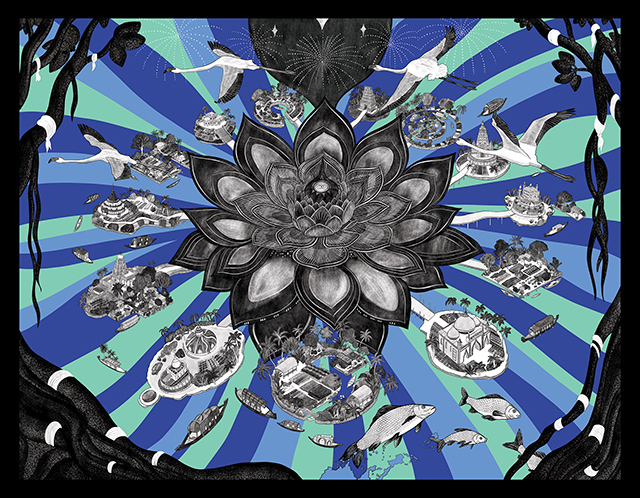
In her speech, Veena highlights the crucial role that corals and mangroves play as living shields or walls. Far from being mere decorative or ornamental, corals are powerful allies protecting the coastal communities. Coral reefs break the force of waves, reducing the impact of erosion and storms on coastlines. Meanwhile, mangroves play a complementary role. Their intertwined roots hold the soil, filter water and shelter essential biodiversity creating an ecosystem. Veena also highlights their critical role in CO₂ sequestration. « We must learn to listen to nature and understand the mechanisms of resilience that it has built as part of their evolution”. According to Veena, the response to climate change cannot rely solely on fixing it with technological solutions.
Carbon capture: A global challenge
Carbon dioxide (CO2) is a gas that is naturally present in the atmosphere, but its concentration has reached unprecedented levels, exacerbated by human activity. ‘The amounts of carbon dioxide in the air (also known as greenhouse gas) have never been higher.’ The excessive accumulation is one of the key drivers for climate change, particularly contributing towards rise in global temperatures. Extensive human activities such as burning fossil fuels, urbanisation and industrialisation’ are key contributing factors.
Technology solutions for combating rising CO2 levels
Veena points out that this needs to be addressed not as a singular issue but a more ‘holistic approach’ is needed involving not just reducing the emission levels and also actively capturing the atmospheric carbon dioxide. This solution is not simple, as it requires varied and combined strategies. Veena indicates that technology solutions for CO2 capture ‘require huge areas of land and the availability of resources’ for their implementation. She points out that although carbon dioxide capture ‘can help us address some imminent threats’, it ‘consumes a lot of energy’ and remains an energy-intensive solution.
On the other hand, more environmentally friendly alternatives exist, such as sequestering carbon dioxide and turning it into something ‘useful’, such as infrastructure materials like cement to meet growing urban demand. This process firstly reduces emissions from cement production plants and secondly captures CO2 in the construction materials. Other innovative solutions are where the ‘carbon dioxide sequestration’ uses organisms like fungi which in turn sequesters CO2 in ‘eco-building blocks’. These have found use in infrastructure projects like building partition walls or to build acoustic screens.
Natural solutions and approaches: Protecting and Conserving Marine ecosystems
There are no better alternatives than natural solutions. Veena emphasises the importance and role of natural ecosystems in carbon dioxide sequestration: « Forests can naturally sequester carbon dioxide and give us back oxygen. Also when you look at coastlines, some marine ecosystems can sequester CO2 more effectively than any technology solutions available today.” She cites an example of Kelp, a type of seaweed that resembles underwater forests. These act like “a forest, a biodiversity-rich ecosystem » and have the ability to absorb far more higher concentrations of carbon dioxide while releasing oxygen that in turn protects the marine ecosystem.
The need for an integrated approach
Today, the solution to climate change lies in a combination of technological and natural solutions. “None of these solutions are free. Each has its own risks, and none of them is a complete solution by themseleves.” However, Veena believes that ‘when integrated, they can really deliver the benefits.’ She concludes on a positive note, reminding us that, as global citizens, ‘it is this concerted action and conscious choices that we must make to deliver these integrated solutions.’
Re-build Natural barriers against rising sea levels
Rising sea levels pose a major threat to coastal cities. According to Veena, ‘One of the biggest threats to these coastal cities is sea level rise or torrential rains, storms or cyclones.’ In the past, ‘natural barriers’ such as mangroves and coral reefs protected these coastlines from flooding and erosion. However, these barriers have been greatly reduced by human activity and climate change. ‘The green walls, made up of mangroves and other coastal ecosystems, no longer exist, exposing coastal cities to all these dangers.’
Restore: Mangrove ecosystem as a viable solution
‘Mangroves provide natural barriers against these adversities, preventing flooding and erosion.’ These ecosystems ‘support a rich biodiversity of animals and birds, creating a vast ecosystem around them.’ The restoration of these ecosystems has helped prevent disasters. Veena cites compelling examples, notably in Mozambique, Ghana and China, where restoration initiatives have ‘reduced damage to coastal towns.’
Conserve: Coral reefs as barrier to under threat
Coral reefs, in addition to being a vital marine ecosystem, have also acted as a natural barrier against flooding. ‘Coral reefs have always been a natural barrier, protecting coastlines from flooding and erosion.’ However, rising ocean temperature is a threat to corals, leading to bleaching and damages of coral reefs. Although many global efforts are being made to restore them, ‘coral reefs are particularly vulnerable to rapid climate change.’
Conclusion: A need for collective response to the crisis
Climate change requires a collective approach that not only combines technological and natural solutions but demands a large-scale behavioural change. Veena emphasises that ‘every small action counts’ and that it is necessary to integrate ‘ecological and technological solutions to effectively combat this global threat.’ Whether it is through the restoration of marine ecosystems or innovation in building materials, Veena stresses that ‘the adoption of sustainable solutions and the commitment of every citizen is essential’ to counter this crisis.
Testimonies from the same panel
